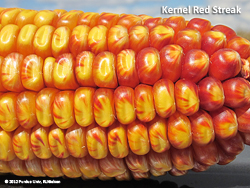September 2017
URL: http://www.kingcorn.org/news/timeless/KernelRedStreak.html
Kernel Red Streak in Corn
R.L. (Bob) Nielsen
Agronomy Dept., Purdue Univ.
West Lafayette, IN 47907-2054
Email address: rnielsen at purdue.edu
Twitter: @PurdueCornGuy
![]() ernel red streak, or KRS, is a phenomenon wherein streaks of red pigments radiate throughout the pericarp of an otherwise yellow kernel. On a bright, sunny day, the combination of red and yellow is strikingly beautiful. The occurrence of kernel red streaking does not seem to restrict itself to fields of "good" corn or "bad" corn. Some hybrids seem to exhibit KRS more often than others, but those may simply be random chance observations.
ernel red streak, or KRS, is a phenomenon wherein streaks of red pigments radiate throughout the pericarp of an otherwise yellow kernel. On a bright, sunny day, the combination of red and yellow is strikingly beautiful. The occurrence of kernel red streaking does not seem to restrict itself to fields of "good" corn or "bad" corn. Some hybrids seem to exhibit KRS more often than others, but those may simply be random chance observations.
The KRS symptom was apparently first documented in 1963 in fields throughout northeast Indiana, southern Michigan, and northwest Ohio (Anonymous, 1963) and in Ontario in 1964 (Wall & Mortimore, 1965). By 1966 (Williams, 1966), researchers had begun to associate the KRS symptom with the concomitant presence of the wheat curl mite (Aceria tulipae K.; aka Aceria tosichella Keifer), a pest in wheat and vector of the wheat streak mosaic virus (WMSV). Researchers in South Dakota reported in 1969 that KRS could be caused by artificially infesting kernels with wheat curl mites during the grain filling period. The severity of the KRS development was more severe with infestations of mites carrying the WSMV, but also occurred with infestations of virus-free mites.
Earlier research (Nault et al., 1967) had suggested that the WSMV was not the cause of the red streaks, but rather the pigmentation resulted from "salivary phytotoxins" secreted by the mites as they fed on the pericarp of kernels. Their work was confirmed by research published from Ontario a year later (Slykhuis et al., 1968). Much later research from Ontario documented the correlation between wheat curl mites and incidence of KRS; as well as the relationship between distance from mite-infested wheat fields and incidence of KRS in adjacent corn fields (Liu et al., 2005).
Growers often worry that the red streaks may signify the presence of ear molds or toxins, but there is no such documented relationship. The most frequent concern with KRS occurs with food grade corn grown under contract for snack food processors. While purely cosmetic, the red pigmentation in the pericarp can discolor the finished products (e.g., corn chips, tortilla chips, taco shells) and, apparently, deter some customers. This appears to be especially true for the wet milling industry wherein the pericarp is not always removed prior to the alkaline cooking process and the remaining pigmented pericarp pieces can turn black with the cooking. Thus, the snack food industry is not keen on purchasing corn grain with high levels of KRS.
Trivia: Though not part of the official grade requirements for corn, the U.S. Standards for Corn (http://www.gipsa.usda.gov/fgis/standards/810corn.pdf) define "yellow corn" as corn that is yellow-kerneled and contains not more than 5 percent of corn of other colors. "White corn" is similarly defined as corn that contains not more than 2 percent of corn of other colors. Grain that does not meet either of these definitions is defined as "Mixed corn". Specifications for food grade corn grain usually refer to #1 yellow or white dent corn.
I have yet to find any research that offers an alternative cause of KRS in yellow dent corn. However, research published by Lee et al. (2009) describes a similar, but reportedly unrelated, phenomenon in white corn that they defined as purple kernel streak (PKS). They distinguished the purple pigmentation of PKS (caused by anthocyanins) from the red pigmentation of KRS (caused by phlobaphenes) and identified different genetic pathways that control the development of the pigments. Their paper suggests that cold temperatures late in the grain filling process may trigger the formation of the anthocyanin pigments in the kernels of sensitive white corn hybrids.
Related reading
Anonymous. 1963. MSU, USDA analyze “red-stripe” corn in Mich-Ind-Ohio. Seed Trade News 81: 24.
Lee, E.A., J.A. Young, F. Azizi, S. Jay, and A.W. Schaafsma. 2009. Phenotypic and Genotypic Characterization of Purple Kernel Streak in White Food Corn. Crop Science 49(4): 1235–1241.
Liu, J., E.A. Lee, M.K. Sears, and A.W. Schaafsma. 2005. Wheat Curl Mite (Acari: Eriophyidae) Dispersal and Its Relationship with Kernel Red Streaking in Maize. Journal of Economic Entomology 98(5): 1580–1586.
Nault, L.R., M.L. Briones, L.E. Williams, and B.D. Barry. 1967. Relation of wheat curl mite to kernel red streak of corn. Phytopathology 57: 986–989.
Slykhuis, J.T., C.G. Mortimore, and L.F. Gates. 1968. Kernel Red Streak of Corn in Ontario and Confirmation of Aceria tulipae (K.) as the Causal Agent. Can. J. Plant Sci. 48(4): 411–414.
Townsend, Lee, Doug Johnson, and Don Hershman. 1996. Wheat Streak Mosaic Virus and the Wheat Curl Mite. Univ of Kentucky Extension publication ENTFACT-117. Online at https://entomology.ca.uky.edu/ef117 [URL accessed Sep 2017].
Tunac, J.B., and Nagel, C.M. 1969. Kernel red streak of dent corn. Plant Disease Reporter 53: 660–662.
Wall, R.E., and C.G. Mortimore. 1965. Red striped pericarp of corn. Can. Plant Dis. Survey 45: 92–93.
Williams, L.E. 1966. Kernel red streak (KRS) of corn. Proceedings of the Annual Hybrid Corn Industry-Research Conference 21: 18–22.


